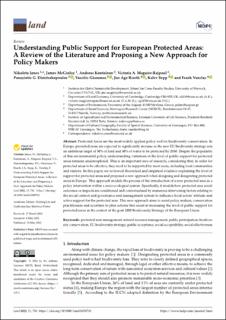| dc.contributor.author | Jones, Nikoleta | |
| dc.contributor.author | McGinlay, James | |
| dc.contributor.author | Kontoleon, Andreas | |
| dc.contributor.author | Maguire-Rajpaul, Victoria A. | |
| dc.contributor.author | Dimitrakopoulos, Panayiotis G. | |
| dc.contributor.author | Gkoumas, Vassilios | |
| dc.contributor.author | Riseth, Jan Åge | |
| dc.contributor.author | Sepp, Kalev | |
| dc.contributor.author | Vanclay, Frank | |
| dc.date.accessioned | 2022-06-02T08:01:58Z | |
| dc.date.available | 2022-06-02T08:01:58Z | |
| dc.date.created | 2022-05-09T09:55:20Z | |
| dc.date.issued | 2022 | |
| dc.identifier.citation | Land. 2022, 11 733-?. | en_US |
| dc.identifier.issn | 2073-445X | |
| dc.identifier.uri | https://hdl.handle.net/11250/2997318 | |
| dc.description.abstract | Abstract: Protected Areas are the most widely applied policy tool for biodiversity conservation. In Europe, protected areas are expected to significantly increase as the new EU Biodiversity strategy sets an ambitious target of 30% of land and 30% of water to be protected by 2030. Despite the popularity of this environmental policy, understanding variations in the level of public support for protected areas remains underexplored. This is an important area of research, considering that, in order for protected areas to be effective, they need to be supported by most users, including local communities and visitors. In this paper, we reviewed theoretical and empirical evidence explaining the level of support for protected areas and proposed a new approach when designing and designating protected areas in Europe. This approach models the process of the introduction of a new protected area as a policy intervention within a socio-ecological system. Specifically, it models how protected area social outcomes or impacts are conditioned and contextualised by numerous intervening factors relating to the social context and governance and management system to influence local actors’ attitude and active support for the protected area. This new approach aims to assist policy makers, conservation practitioners and scientists to plan actions that assist in increasing the level of public support for protected areas in the context of the post 2020 Biodiversity Strategy of the European Union. Keywords: protected area management; natural resource management; public participation; biodiversity conservation; EU biodiversity strategy; public acceptance; social acceptability; social effectiveness | en_US |
| dc.description.abstract | Understanding support for European Protected Areas: A review of the literature and proposing a new approach | en_US |
| dc.language.iso | eng | en_US |
| dc.relation.uri | https://www.mdpi.com/2073-445X/11/5/733/pdf | |
| dc.rights | Navngivelse 4.0 Internasjonal | * |
| dc.rights.uri | http://creativecommons.org/licenses/by/4.0/deed.no | * |
| dc.title | Understanding support for European Protected Areas: A review of the literature and proposing a new approach | en_US |
| dc.type | Peer reviewed | en_US |
| dc.type | Journal article | en_US |
| dc.rights.holder | © 2022 by the authors | en_US |
| dc.description.version | publishedVersion | en_US |
| cristin.ispublished | true | |
| cristin.fulltext | original | |
| cristin.qualitycode | 1 | |
| dc.identifier.doi | https://doi.org/10.3390/land11050733 | |
| dc.identifier.cristin | 2022558 | |
| dc.source.journal | Land | en_US |
| dc.source.volume | 11 | en_US |
| dc.source.pagenumber | 733-? | en_US |

